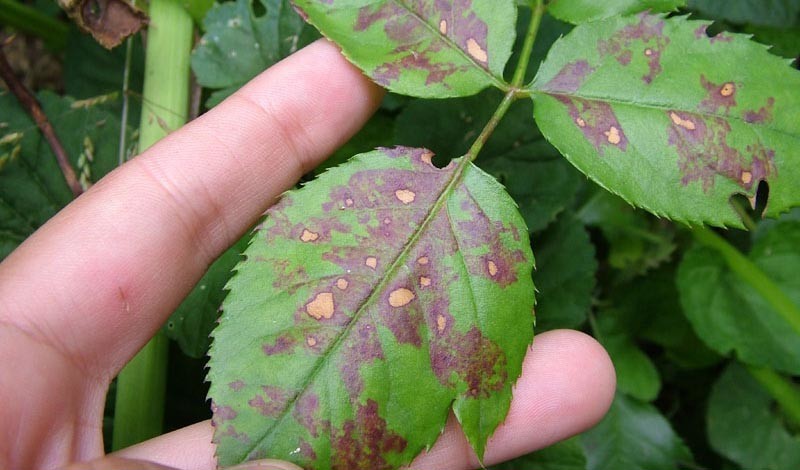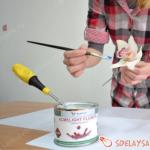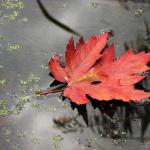Super remedies that will get rid of black spots on rose leaves
The appearance of ugly spots on the leaves can overshadow the charm of flowering rose bushes. The spots can be brown, white, yellow, red, or rusty in color, and in all cases indicate problems with the health of the plant.
Black spot - a fungal disease, the symptoms of which most often appear in the summer, not only significantly reduces the decorative effect of the bushes, but can also interrupt the flowering of roses.
 Black spot in roses is caused by the fungus Marssonina rosae. The causative agent is spread by spores and is activated in conditions of high humidity in warm weather. The most favorable time for the development of the fungus is spring. The disease rarely appears in dry and hot summers.
Black spot in roses is caused by the fungus Marssonina rosae. The causative agent is spread by spores and is activated in conditions of high humidity in warm weather. The most favorable time for the development of the fungus is spring. The disease rarely appears in dry and hot summers.
First of all, bushes growing in lowland areas or surrounded by dense thickets of plants in a flower garden are susceptible to the disease, since these factors prevent the normal evaporation of moisture after precipitation and irrigation. The development of fungi is also facilitated by: lack of lighting or nutrients in roses, potassium deficiency, excess nitrogen, heavy and acidic soils are especially critical.
Symptoms and course of the disease
The disease does not manifest itself immediately, the first signs of damage appear a month after the active development of the fungus. The exception is warm and humid summers, at a temperature of about 30 ° C, the disease becomes noticeable after 10 days. On average, black spot on rose bushes is most likely to be found by mid-summer.
The lesion spreads from the bottom to the top of the bush. Dark brown spots appear on the leaves and shoots, framed by a yellow border. As the disease progresses, other symptoms appear:
- the spots turn black and increase in size;
- twisting and yellowing of leaves is observed;
- fall of foliage from the bushes;
- slowing down and stopping the growth of shoots;
- poor formation of flowers, up to the cessation of flowering.
Attention!
The spores of the fungus overwinter safely in the ground, which makes it likely that the disease will reappear in the next season.
black spot treatment
 The fight against black spot comes down to pruning the affected parts from the bush, treating the plants with antifungal agents and preventive measures that also inhibit the development of the fungus.
The fight against black spot comes down to pruning the affected parts from the bush, treating the plants with antifungal agents and preventive measures that also inhibit the development of the fungus.
Timely spraying of roses with folk remedies, as a rule, gives a positive result, while in the later stages of the disease it is recommended to use chemical fungicides. It is worth considering that after the appearance of the first symptoms, the disease begins to develop very quickly.
The most powerful folk remedies:

Advice!
In autumn, when pruning bushes, affected shoots, regardless of the degree of damage, should be cut to the level of the second or third bud.
Prevention
 Black spot prevention measures include:
Black spot prevention measures include:
- providing roses with suitable conditions for growth;
- compliance with annual sanitary measures;
- preventive treatments in case of risk of disease.
Growing conditions
Prevention of black spot in roses begins with the choice of a place for planting bushes and planning a flower garden.
Culture requires:
- Sun. For roses, sunny places should be allocated where the plants can receive enough light during the day. This will also benefit flowering and the general condition of the bushes.
- Weak soil. When planting on soils with high acidity, it is necessary to carry out a liming procedure - add 250-500 g of dolomite flour or 150-250 g of lime.
- Space. Maintaining a distance between the bushes prevents the rapid spread of the disease. Also, do not surround the bushes with a dense wall of other plants - the fungus often appears where there are obstacles to free air circulation.
- Good food. Roses need to be fed during the growing season, during and after flowering. It is necessary to provide plants with phosphorus, potassium, do not forget about feeding with micronutrient fertilizers, but show reasonable moderation in nitrogen nutrition.
- "Crop rotation". It is advisable not to plant bushes in places where roses have already grown. Planting can be done only 5 years after the cultivation of other crops on this site.
Landing Hygiene
 In spring and autumn, it is necessary to carry out a number of sanitary measures aimed at reducing the risk of diseases in roses.
In spring and autumn, it is necessary to carry out a number of sanitary measures aimed at reducing the risk of diseases in roses.
- It is recommended to remove dry and damaged branches twice a year - when preparing the bushes for wintering and after the release of roses from shelters in the spring. If necessary, thinning crown pruning should also be done.
- In autumn, before placing the roses under cover, you need to clear the bushes of the remaining foliage.
- Since the spores of many fungi, including the black spot pathogen, hibernate in the ground, on the eve of sheltering the bushes and immediately after removing the protection in the spring, the soil under the roses should be treated with a 0.01% solution of copper sulfate. It is recommended to alternate this remedy with a solution of ferrous sulfate.
- In autumn, you can also treat the bushes with Bordeaux liquid or a solution of copper sulphate at a concentration of 3%.
- In the spring, it is worthwhile to spray the roses once with the preparations "Skor", "Profit", "Ridomil Gold" or "Strobi" during the period when the leaves appear. An alternative to this may be two sprayings with biological agents, for example, with Fitosporin-M, performed with a week break.
- Throughout the season, it is necessary to remove weeds from the flower garden that thicken the planting.
On a note!
Bush processing
 If spring or summer turned out to be rainy and warm, you should insure yourself by taking additional measures against fungal diseases. It is recommended to carry out regular weekly treatments throughout the season:
If spring or summer turned out to be rainy and warm, you should insure yourself by taking additional measures against fungal diseases. It is recommended to carry out regular weekly treatments throughout the season:
- Infusion of tobacco. A bucket of water requires 500 g of dried and finely chopped tobacco leaves. Raw materials are poured with boiling water and left for 5 days. Before use, the infusion must be filtered.
- Garlic infusion. Take 200 g of chopped garlic heads and pour a liter of warm water. After 5 days of infusion, the solution is filtered and 1/2 cup is added to a bucket of water.
- Wood ash. Directly during the rainy season, the ashes should be scattered in the near-trunk circle of rose bushes.
resistant varieties
The least resistance to black spot is shown by varieties of such groups as tea, polyanthus and climbing roses. Planting them should be avoided if conditions favor the appearance of the fungus. And the most resistant to damage by spotting are varieties of roses with glossy leaves - their dense skin is "too tough" for the fungus.
Among the most resistant varieties are:
- "Grande Amore";
- "Baronesse";
- Quadra;
- "La Perla";
- "Leonardo de Vinci";
- "Memory";
- "Sebastian Kneipp";
- "Nostalgia";
- Resonance.
The most important thing in the fight against black spot is to provide roses with quality care, since the fungus first of all attacks weak and exhausted plants. If, for some reason, roses are at risk, it is necessary, without waiting for the appearance of diseases, to take measures to restore their resistance to adverse factors. To do this, they introduce a special feeding regimen (enhanced potassium nutrition), water the bushes with growth stimulants and use drugs to strengthen the immunity of roses.




